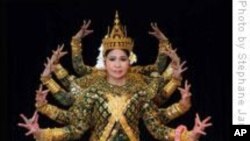A Buddhist dance troop visited the Asian Arts and Culture Center in Maryland earlier this month to perform “Agangamsor and His Magic Power,” a uniquely Khmer adaptation to the Indian Ramayana.
The troop, from the Cambodian Buddhist Society, performed at Towson University, on Nov. 7. Its musicians and dancers are little-known treasures in the US state.
Master artist Mani Massady was trained at Cambodia’s Fine Arts University. Composer and “roneat aik,” or lead xylophone, player Chum Ngek and producer, lyricist and singer Say Sara were leaders of professional music ensembles in Cambodia who revived their arts in refugee camps and the United States since late 1970. Several up-and-coming dancers and musicians trained under these masters.
“Agangamasor” is the prequel to the Reamker, the story of the hero, Preah Ream, or Rama, who is the earthly incarnation of Preah Noreay, or Vishnu, the guardian of the universe.
Much of Khmer classical dance drama is based on Cambodian literature, especially the Reamker. While this part of the Reamker is common knowledge among older Cambodians, it has not been retold on stage until this production.
Suewhei Shieh, director of the Asian Arts and Cultural Center of the Towson University, told VOA Khmer that the center’s programming tries to present different types of arts, including performing arts and visual arts from all over Asia.
“Agangamsaor” is part of the “spiritual rhythm of Asia” series, she said, and fit with this year’s focus on spiritual and healing arts.
“Their preservation and creativity for this show are a very unusual, unique type of arts,” she said. “It is very admirable.”
Shieh said she hopes that other Asian cultures and people can follow such an example to preserve their own unique arts.
Saul Gorzelor, an employee at the World Bank, in Washington, came to the show and helped document the performance for the Cambodian Buddhist Society.
He felt “privileged,” he said, to help document a community coming together to keep a tradition alive that was nearly destroyed by the Khmer Rouge, “since all artists were considered suspects.”
“So anything that has to do with beauty and arts, and music and dance and culture, I think it is interesting,” he said.
Caroline Dantzler, a ballet teacher at Lake Twelve Ballet Academy in Ellicott City, Md., said ballet is a little different from Cambodian classical dance, because it moves around the space more, while some of the movements are more off the floor and the flow is also a bit different. The forms are similar, however, in the discipline and elegance, she said.
“The dancers were artists, and I truly enjoyed it, and I am so grateful that I had the chance to see it,” she said. “I love the flow of it, an the way it tended to tell the story about that the way they moved was lovely. The lines they made are very difficult. I think they must be very trained and they were beautiful. And the dancers expressed more than the words did, very much more.”
Sonhie Halmilton, a Malaysian-American housewife who has lived in the Towson community for 36 years, said she enjoyed coming to all Asian Cultural events at the university.
“It is great to see the culture coming back so quickly,” she said of the Cambodian performance. “You heard about Cambodia and the tragedy that took place. The people had no trace of any trauma, and yet the spirit and culture are so alive and inspirational. It is just quite fascinating.”




